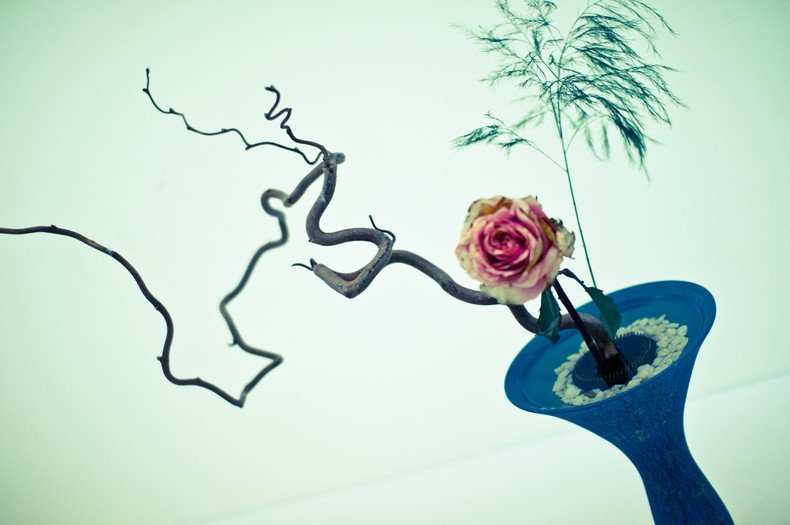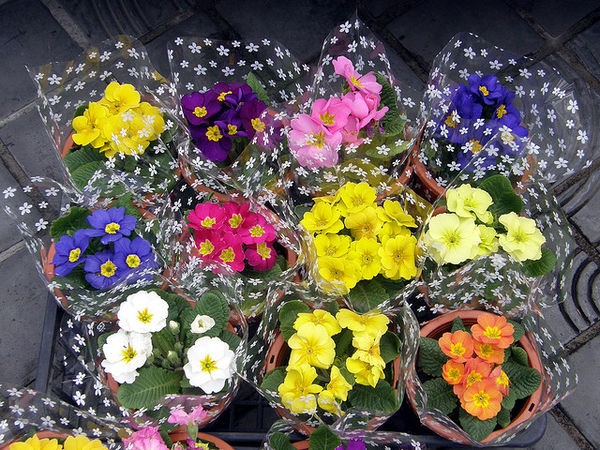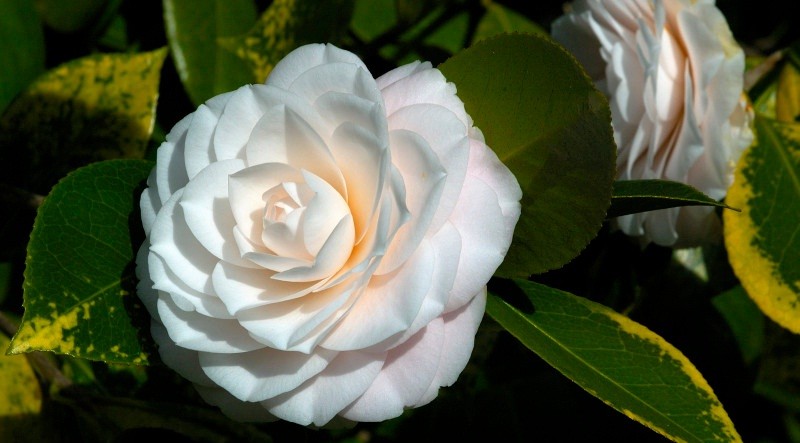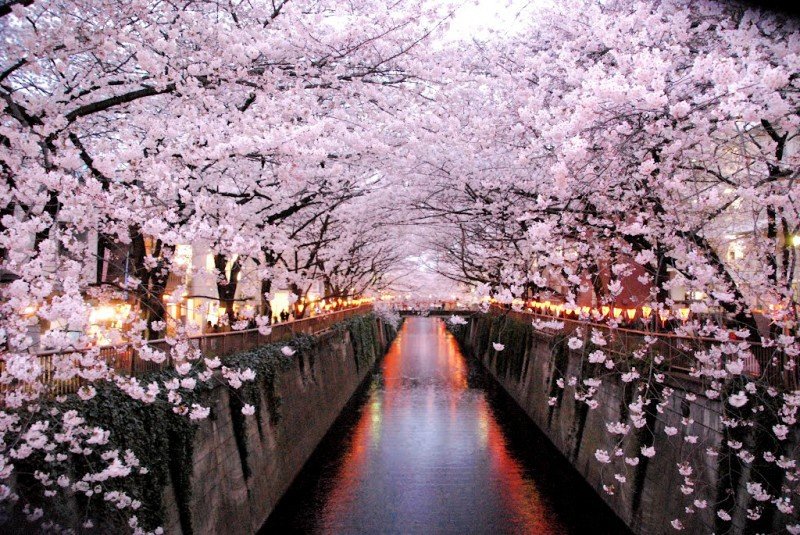Have you heard about the language of flowers? Do you know how to say the names of the flowers in Japanese? What meanings do flowers have in Japan? In this article, we will see everything about Hanakotoba [花言葉] and the meaning of flowers in Japanese.
Flowers like sakura and chrysanthemum are national symbols of Japanese culture, and they hold great power in the beauty of the country and in the lives of the Japanese. In Japan, flowers are a traditional gift for both men and women.
They are often used to convey what cannot be spoken. The language of flowers is known as Hanakotoba [花言葉] and is disappearing. Nowadays, many Japanese do not know that flowers have traditional meanings.
However, flower meanings make occasional appearances in modern popular culture such as anime and manga. In this article you will learn both the meaning of flowers and their pronunciation and writing in the Japanese language.

The image above shows a Japanese flower arrangement called Ikebana.
Table of Content
Flowers in Japanese - Meaning of Flowers
Below we will leave a complete list of flowers in Japanese, followed by their writing in kana, their romanization and finally their meaning. If you're on your cell phone, just slide your finger over the table to move it and see it completely.
Responsive Table: Scroll the table to the side with your finger >>
| Flower name | Japanese | Romaji | Meaning |
| Amaryllis | アマリリス | Amaririsu | Shy |
| Ambrosia | アムブロシアー | Ambuuroshiā | Pious |
| perfect-love | パンジー | Panjī | thoughtful, caring |
| Anemone (White) | アネモネ | Anemone | Sincere |
| Aster tataricus | 紫苑 | Shion | Remembrance |
| azalea | 躑躅 | Tsutsuji | patient, modest |
| Bluebell | ブルーベル | Burūberu | Grateful |
| Cactus | サボテン | sabote | lust, sex |
| Camellia (Yellow) | 椿 | Tsubaki | Wish |
| Camellia (White) | 椿 | Tsubaki | Waiting |
| Camellia (red) | 椿 | Tsubaki | In love, Perishing with grace |
| Clove | カーネーション | Kānēshon | Fascination, distinction and love |
| Chrysanthemum (yellow) | 黄菊 | Kigiku | Imperial |
| Chrysanthemum (white) | 白菊 | Shiragiku | Truth |
| Dahlia | 天竺牡丹 | Tenjikubotan | Good taste |
| Edelweiss | エーデルワイス | Ēderuwaisu | courage, power |
| Érica | エリカ | Erika | Loneliness |
| sweet pea | スイートピー | Suītopī | Goodbye |
| Cherry Blossom | 桜 | Sakura | Kind, Gentle, Transience of Life |
| Freesia | フリージア | furjia | childish, immature |
| Fritillaria camschatcensis | 黒百合 | Kuroyuri | love, curse |
| Gardenia | 梔子 | Kuchinashi | Secret love |
| Sunflower | 向日葵 | Himawari | Respect, passionate love, radiance |
| morning glory | 朝顔 | Asagao | voluntary pledges |
| Habenaria radiata | 鷺草 | Sagisō | My thoughts will follow you in your dreams |
| Hibiscus | ハイビースカス | Haibīsukasu | □ Kind |
| Hydrangea | 紫陽花 | Ajisai | Pride |
| Iris | アイリス, 菖蒲 | Ayame | Good News, Good News, Loyalty |
| Jasmine | ジャスミン | Jasumin | friendly, graceful |
| Lavender | ラベンダー | Rabendā | Faithful |
| lily (orange) | 小百合 | Sayuri | hate, revenge |
| White lily) | 白百合 | Shirayuri | Purity, Chastity |
| red spider lily | 彼岸花 /曼珠沙華 | Higanbana /Manjushage | Never to meet again, Lost memory, Abandonment |
| Lily of the Valley / Spider Lily | 鈴蘭/百合 | Suzuran/Yuri | Sweet |
| Lotus | 蓮華 | Renge | Away from the one he loves, Purity, Chastity |
| Honeysuckle | 忍冬 | Suikazura | Generoso |
| Magnolia | マグノリア | Magunoria | Natural |
| Daisy | 雛菊 | Hinagiku | Faith |
| Do not forget me | 勿忘草 | Wasurenagusa | True love |
| Narcissus | 水仙 | Suisen | Respect |
| Narcissus | 水仙 | Suisen | Self esteem |
| Poppy (Yellow) | 芥子(黄) | Keshi(Ki) | Success |
| Poppy (white) | 芥子(白) | Keshi(Shiro) | cheer |
| Poppy (red) | 雛芥子 | Hinageshi | fun-loving |
| Peony | 牡丹 | Botan | Bravery |
| Primrose | 桜草 | Sakurasō | Desperate |
| Pink (Yellow) | 黄色薔薇 | Kiiroibara | Jealousy |
| Pink (White) | 薔薇 | Bara | Innocence, Silence, Devotion |
| rose (pink) | 桃色バラ | Momoirobara | Confidence, Happiness, Confidence |
| Red rose) | 紅薔薇 | Benibara | passionate love |
| Tiger Lily | 鬼百合 | Oniyuri | Wealth |
| four-leaf-clover | (四つ葉の) クローバー | (Yotsuba no) kurōbā | Fortunately |
| Tulip (yellow) | チューリップ | Chūrippu | One-sided love |
| Tulip (red) | チューリップ | Chūrippu | Fame, Charity, Trust |
| Verbena | 美女桜 | Bijozakura | Cooperative |
| Violet | 菫 | Sumire | Honesty |
| Mistletoe / Holly | 宿り木/ホーリー | Yadorigi/Hōrii | Seeking (Single and "-") |
| Zinnia | 百日草 | Hyakunichisou | Loyalty |
Meaning of Flowers - Japan vs West
What do you think about briefly comparing the meaning of Japanese flowers with the meaning of flowers in the West? Are there any differences? Take a look at our old list of hanakotoba before the update of this article.
Red rose (Akaibara, 赤い薔薇) - It means romance just like the western meaning.
White Rose (Shiroibara, 白い薔薇) - In Japan it means Innocence, Devotion and Silence. In the West it means Virtue and Chastity.
Yellow Rose (Kiiroibara, 黄色い薔薇) - In Japan it means Jealousy and Envy. In the West it means Friendship and Devotion.
Pink Rose (Pinku no bara, ピンクの薔薇) - In Japan it means Trust and Happiness. In the West it means Grace, Elegance and Delicacy.
Carnation (Kaneshon, カーネーション) - In Japan carnations literally mean love, red carnations are a great gift for Mother's Day. In the west it depends on the color, red means romantic love, yellow means rejection.

Amaryllis (Amaririsu, アマリリス) - Japanese meaning is "shy" western meaning is "proud".
Red Tulip (Akaichurippu, 赤いチューリップ) – In Japan it means "Fame" in the West it means eternal love.
Yellow Tulip (Kiiroichurippu, 黄色チューリップ) – In Japan it means a one-sided (unrequited) love, in the West it means the same thing, but it also means an impossible love.
Primrose (Sakuraso, 桜草) - In Japan it means despair, in the West it means eternal love, pure friendship and kindness.

Sweet Pea Flower (Suitopi, スイートピー) – In Japanese it means Goodbye, a farewell.
Blue Bell or Bluebell (Buruberu, ブルーベル) – Both in Japan and in the West it means "Gratitude".
Cactus Flower (saboten no hana, さぼてんの花) – In Japan it means lust, in the West it means a mother's love.
Narcissus (Suisen, 水仙) - In Japan it means "Respect" in the West it means chivalry or unrequited love.
Camellia (Tsubaki 椿) - In Japan the red Camellia means "Love" for the samurai it means "bad luck". The yellow camellia means longing. The White Camellia means "Wait" and in the West both colors mean Excellence.
White Chrysanthemum (Shiragiku, 白菊) - In Japan it means truth or sadness, it is the most common flower used at funerals. In the West it means death and mourning.

Sakura - Meaning of Cherry Blossom [桜] [櫻]
Sakura (桜) literally means cherry tree and is one of the main symbols of Japanese culture. THE cherry blossom, has such an intense meaning and symbology that it would need a long article talking about it. But I will summarize:
the cherry blossom means the female beauty and symbolizes the love, a happiness, a renovation and the hope. It also symbolizes clouds as they bloom en masse. A The flowers' compromise, their extreme beauty and quick death, was often associated with mortality.

The sakura is a good luck charm and is also an emblem of love, affection and represents spring. Sakura Blossom is divided into more than 300 varieties of cherry trees, and they refer to many other different meanings.
The fruit of the cherry tree, the cherry, is considered the greatest symbol of sensuality, eroticism, and sexuality, mainly due to its intense red color. The sakura is so appreciated that every year during spring it is enjoyed at a festival called Hanami.
Of course, there are countless meanings of Sakura and other flowers that haven't been mentioned, otherwise the article would turn into a book. Thanks to everyone who read the article and the comments and shares. Which flower do you like the most?
